It’s been a week of dodging showers or just ignoring them and getting wet. I managed to plant some wood anemones and a few bulbs, about ten, small ones. Bagged my first Camellia picture of the season too, though this is the wrong blog for that and it wasn’t one of mine, unusually.
I was thinking about insects. There seemed to be worryingly few early in the year but by high summer I was very pleased by how many the garden was attracting. I have a hunch that over tidying a garden in winter is not helpful to the overwintering phase of their lifecycles in many cases and this is the beginning of clean-up season. They must go somewhere to get through. Any thoughts?
One.
Begonia grandis evansiana. Linnaeus came up with the binomial system for naming plants because plant names were often ridiculously long. The full name for this is given on the RHS website as Begonia grandis Dryand. subsp. evansiana (Andrews) Irmsch. var. alba hort. That’s the white one. I don’t know which clone the pink belongs to. It’s growing in full but not dense shade and was started last year from bulbils. They were planted out from 9cm pots this spring and are at least 2 feet tall, looking really good at this time of year. It’s hardy in milder areas.

Two.
Haemanthus albiflos. I have two reasons for growing this; nostalgia, I grew it as a kid and the name, which I find inordinately pleasing for no reason I could explain to anyone. It’s not hardy, I grow it in a pot.
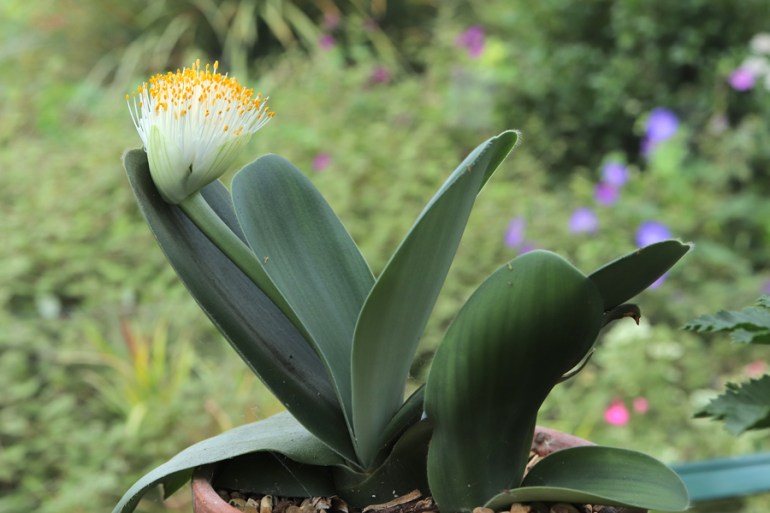
Three.
I’m just going to call this Crataegus prunifolia, though I think it’s been elevated to cultivar status. One of the most ornamental hawthorns, it has big bright red berries and glossy plum like leaves which in good autumn colour areas can be spectacular. It has wicked thorns but not many of them. Blackbirds will eat some of these and knock the rest off onto the ground. I swept them up last year and put them in my allotment compost, the reward for which has been carpets of seedlings around my onions. It’s actually in next door’s garden and mercifully they haven’t cut it down yet. It hangs several feet over the fence.
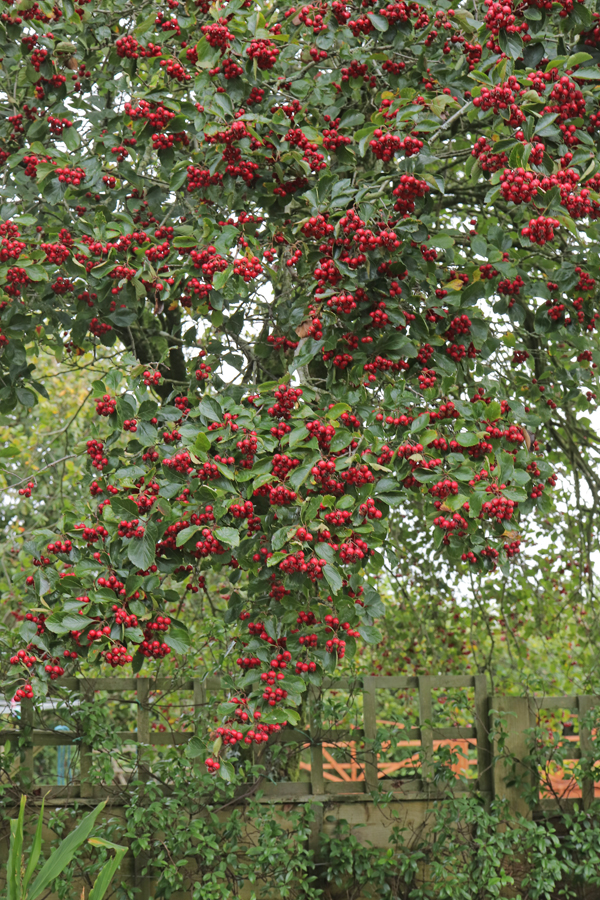
Four.
Cyclamen seedlings. I collected seed from some of my Cyclamen this year and sowed it in early August. I think I may have got a bit carried away. All of these are C. hederifolium but there’s a pot of C. coum coming up like cress too. Oh, there’s another seed tray of C. hederifolium coming up too. The two pots of C. repandum aren’t showing at all yet though. I joined the Cyclamen Society this week, so next year I shall have even more seed to grow. Should have covered these with grit, stop moss growing a bit.
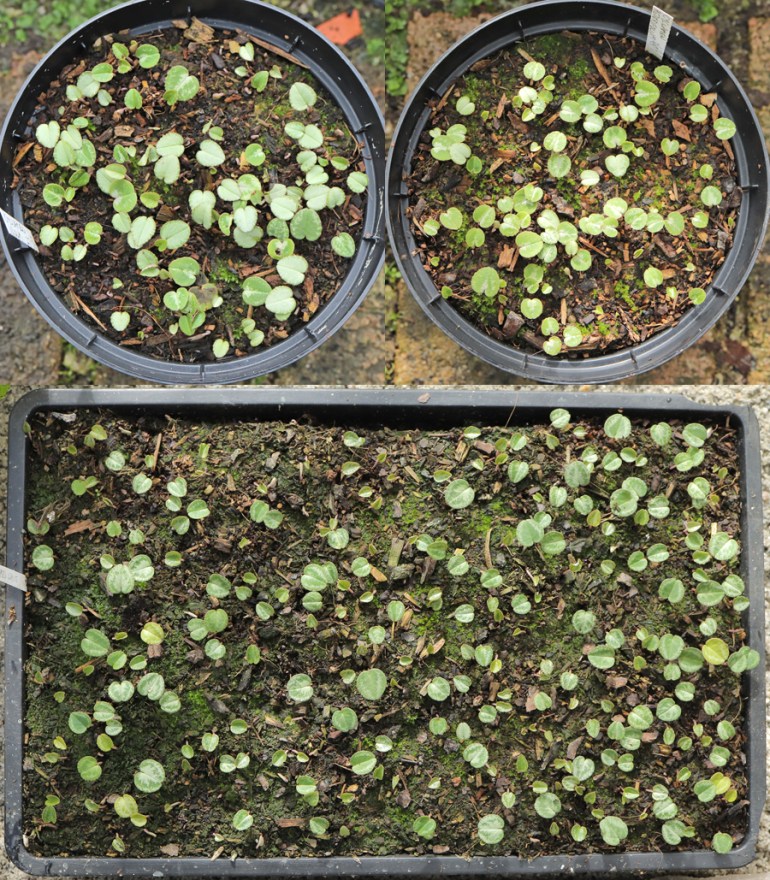
Five.
I spotted a couple of butterflies on my Aster so went scurrying indoors for a telephoto lens. Amazingly they were still there when I came back out, they’re in the featured image. While I was snapping away I glanced up to see that my Schefflera taiwaniana has flowers coming. The beast got the last lot, I wonder if these will fare better. The red flowers in front are Salvia confertiflora which are about eight feet tall now.
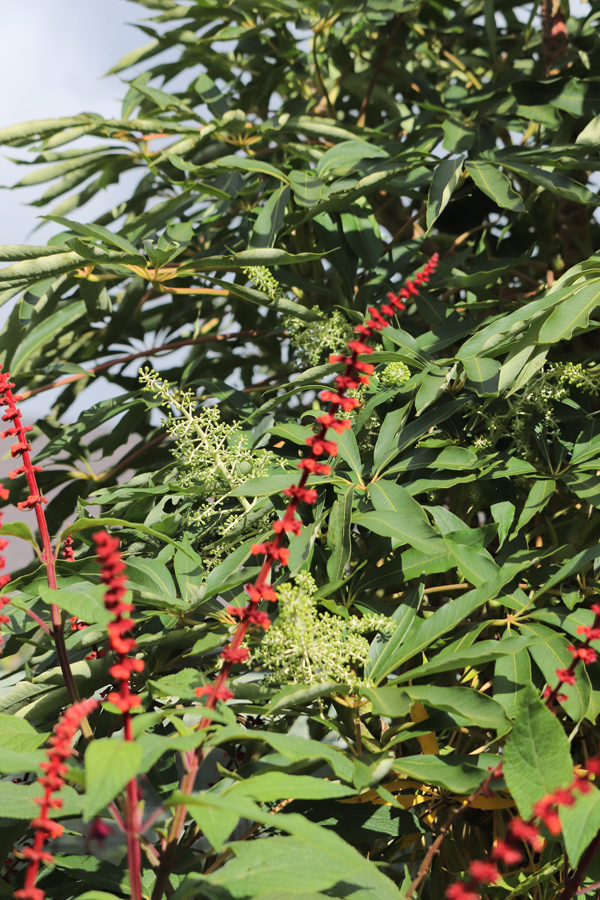
Six.
Impatiens auricoma x bicaudata is a thing we used to grow only in pots indoors, then discovered a couple of years ago that it does very well planted as a bedding plant. It won’t survive even the lightest frost but it flowers its head off for months and is easy from cuttings. This week I noticed that it was setting what looks like viable seed. The pods explode when you touch them. You know the rest. I’ll let you know how they do and how they turn out. The plants that are horribly pot bound in 3 litre pots are flowering better than the ones in the ground, though they look a bit hungry. Poor soil is better then. Hope it’s not the next Himalayan Balsam.
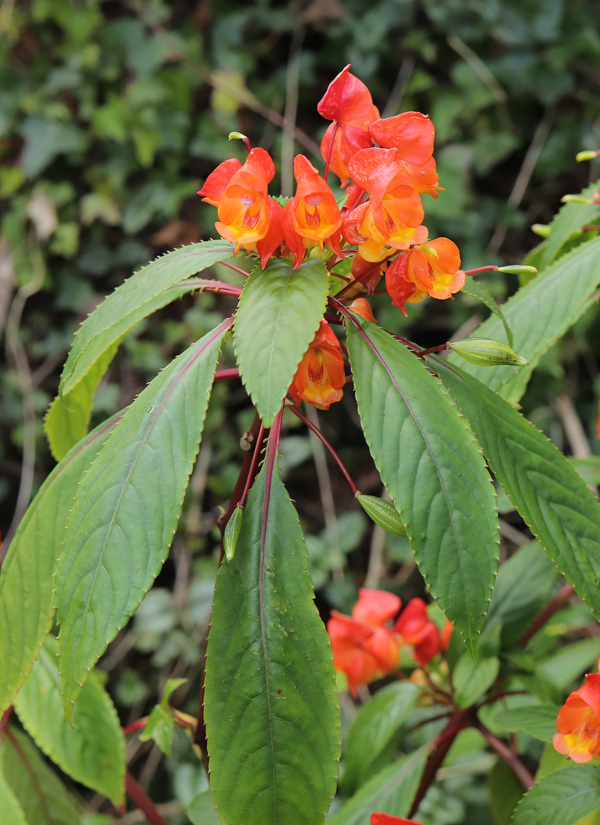
It’s not very inviting outside just now, dull and grey. Perfect for the weekend pastime of peering into other peoples gardens via the medium of Six on Saturday, hosted by The Propagator. The links are rolling in as I write.
The hawthorn is rad. It is one of those species that was introduced here, but never became popular. I think if I were to grow it, I would probably get a North American species. They are not as pretty, but I would like to get acquainted with at least one such species. I have worked with the other hawthorns, which we know as English hawthorns, but only on rare occasion. There is one at work with rich rosy pink bloom. I happen to like it enough to maybe grow copies of it for other landscapes (but not my garden) this winter.
LikeLike
Haemanthus albiflos is . . . unique. I have never seen it before.
LikeLiked by 1 person
The Hawthorn is in fact an American species, a selection of Crataegus persimilis, made before 1800. It is by far the most planted non-native thorn grown in the UK though still not really common. The pink and red flowered thorns are forms of Crataegus laevigata which is native to Western Europe, including Southern England. It’s not uncommon to see pink flowered forms in the wild but whether that’s because they’ve picked up pollen from garden trees or they are the source of the pink colour in garden forms I don’t know. Hawthorn is mainly planted for rural hedges and much of the material is of European origin, as it has been for centuries.
LikeLiked by 1 person
How cool, but unexpected, that you have an American species. I should have recognized the name, since it happens to be native to Pennsylvania. (Pennsylvania happens to be one of those places where I would like to learn more about native flora.) Of the rare hawhtorns here, Crataegus laevigata is also the most common species. Actually, it is the name assigned to all hawthorns that we can not identify, even Crataegus monogyna. There is an old home near here that has a pair of hawthorn hedges flanking the driveway. Unfortunately, they are not maintained well at all, and just get chopped back horridly every year or so. I suspect they are English hawthorn, but I really don’t know.
LikeLike
You have to wonder how likely it is that a species from Europe, growing in America surrounded by American species, and then propagated from seed for several generations, is still what it started out as. Hawthorns are difficult enough to identify to begin with.
LikeLiked by 1 person
The few hathorns that were planted in the past few decades are cultivars that are likely the same as those in Europe. Because there are no native hawthorns here, the hawthorns that predate modern cultivars had nothing to hybridize with, so are likely still the same species that they had always been. (They never naturalized, and are not grown from seed anyway.) Within the native ranges of North American species, which happens to be where English hawthorn is more popular, it is probably impossible to say what has naturalized, and what now grows wild, or even what was grown for landscape purposes a long time ago. It is something I do not want to consider if I ever get seed for Kansas hawthorn.
LikeLike
There was a time when Crataegus tanacetifolia was quite high on my wanted list. I look at pictures of it now and wonder why. I must have seen a good one somewhere.
LikeLiked by 1 person
We don’t always need an excuse. Some of the Yuccas I want are not at all appealing, but I find them intriguing.
LikeLiked by 1 person
Hi Jim, It’s been a while since I checked in on your garden and as ever you’ve posted some interesting things. Haemanthus really caught my eye. I love things that have that flower form. It’s a bit like a myrtle isn’t it?
On the grit, my late friend Mr Snowdrop had a big collection of cyclamen and he always top dressed with grit. They survive in the wild without it though. Your fabulous seedlings don’t seem to mind the moss!
LikeLike
A bit like Myrtle, in the sense that it’s just a brush of stamens, but bigger. The grit would be to make it easier for the leaves to come through in the second year, it being my intention to leave the seedlings undisturbed for at least a season, probably two. I have a tray from last year which is covered with moss, must get around to doing something with it, the cyclamen may well be trapped underneath. This years haven’t gone mossy yet but they will.
LikeLike
That is such a rich orange colur of that imaptiens.. Haemanthus albiflos seems an ineresting plant. I will have to see if I van get my hands on one.
LikeLike
I found numerous seedlings around the Impatiens today, doomed to die with the first frost, perhaps I should pot a few up and bring them in. Massonia is quite similar to Haemanthsus albiflos. There are so many plants I want to grow and I feel I’m running a little short on time, not to mention space.
LikeLiked by 1 person
I have been changing the way I plant themYou may have realised I have a bit of an obsession with succulents. So much so I have started taking them out of my tound terrecott pots and putting them in square ones so I can put more in cold frames
LikeLike
The square pots will be plastic though, so you’ll really need to be careful with the watering. There are no easy answers to not having enough space.
LikeLiked by 1 person
I am encouraged by your begonia success. I must check the preferred conditions for mine, I didn’t think to check for shade preference. But, begonia schmegonia, I am most tickled by your cyclamen seedlings. I’ve never tried to collect seeds from my expanding colony. Must have a look next summer.
LikeLike
The least interesting ones tend to be the most fecund and by the time the seeds ripen I’ve forgotten what the flowers were like. I must tag the best ones while they’re in flower this year. There may be surplus seed.
LikeLike
As always a great selection. The cyclamen seedlings are impressive.
LikeLike
Those seedlings have lit a small fuse. I joined the Cyclamen Society, could be the latest in a lifetime of serial obsessions.
LikeLiked by 1 person
The Impatiens auricoma x bicaudata is really pretty. It’s odd how some plants prefer poor soil. fingers crossed with the seeds.
LikeLike
I’m not sure that it does prefer poor soil, the ones in the ground are growing better but flowering less. It’s that thing of putting them under a bit of stress to remind them of their mortality and get them procreating like mad.
LikeLiked by 1 person
Your bug musings make a lot of sense. Will you be less tidy this autumn? That hawthorne next door is stunning. Think I’d get stopped in awe several times a day if it lived next door to myself. When reading about your impatien & looking at the photo, I was thinking, orange Himalayan balsam. Does it have a scent? I love the HB scent, but that can be considered a dirty little secret in some gardening circles.
LikeLike
The things I might tidy would collapse and decay and by spring be almost gone, so may not be where insects overwinter. Bees will make nests in holes in the ground, butterflies can hibernate in sheds and dark places, ladybirds congregate in dense evergreens. Maybe being tidy isn’t a problem, I don’t really know. The Balsam has no scent and doesn’t seem as popular with bees as Himalayan Balsam. I’ve seen wasps and ants on it.
LikeLike
With your temperate ie warm micro climate you can certainly bring on some wonderful plants…love that cyclamen repandum which is crossed off in my metaphorical ispot cyclamen books whilst on holiday in Italy a few years ago.
LikeLike
I saw huge drifts of C. repandum at Killerton some years ago but have only planted some in the last couple of years. They’ve not really taken off yet. I got seed from a friend but none have come up yet. The Cyclamen Society had a white form in their seed list this year.
LikeLike
I should collect some Cyclamen seeds rather than relying on them spreading themselves about. I’ve looked up the Begonia and can only see plants for sale. Can you buy them as bulbils?
LikeLike
The key with Cyclamen seed is to collect it as soon as the pods split, late July-early August and sow them straight away. I’ve not seen Begonia bulbils or sale, they’re somewhat vulnerable to drying out and shrivelling, but I can send you some in a month or so if you want.
LikeLike
More lovely plants. I have noticed some tiny cyclamen leaves popping up near the ones I planted last year so hopefully this means they have self-seeded and I will get more and more flowers over time. I’ve just put some white ones in nearby too and if they all spread it should look lovely eventually! Gardening is such a waiting game.
LikeLike
I have cyclamen popping up miles away from existing plants; supposedly ants disperse the seeds. There’s nothing like them when you see really big drifts.
LikeLiked by 1 person
Well I certainly have ants in the garden. Not to mention the house!
LikeLike
Ants, earwigs, wasps: they’re not easy to love even though they’re supposed to be our friends.
LikeLike
Well, there may not have been many insects early on but those healthy leaves on my broccoli and Brussels are now sporting the lacy look… again! I will leave them for a couple of months but I think two major attacks might be too much. Lovely flowers again, especially the first photo.
LikeLike
Small White caterpillars did most of the damage on my brassicas this year, I’ve never seen so many. The nettle patch I left; nothing on it.
LikeLike
I tend to cut back most plants in the spring to leave sheltering spaces for critters, but I can’t say I’ve ever noticed anything sheltering in them other than caterpillars and snails. Nice butterfly photo montage. Off to google Haemanthus albiflos…
LikeLike
That’d be a trick, to create hibernation niches for insects that slugs couldn’t use. Bug hotels with copper doorways?
LikeLiked by 2 people
A great Six this week! Love the Begonia especially. Yes, insects need a messy garden to protect them over the winter. I’ve trained myself to tidy only what’s necessary to prevent disease from spreading (ie rose leaves, peony foliage and things that will fall and cover pathways) while leaving the rest for a spring cleanup. A bit easier for me, perhaps, since much of the mess will be covered by snow for much of the winter! Also, makes it a bit of a mad rush in the spring but still…for the insects…
LikeLike
I’m thinking most insects would overwinter quite near where they’d been feeding, as eggs, larvae, adults or whatever. The snow would preserve your dead plants to a degree, all turns to mush by spring here so maybe that’s not where they go. Research needed.
LikeLike
I’m impressed by your begonia! I grew up the same white variety but mine remained in pot and didn’t survive the summer. I made the mistake of not putting it in a completely shady corner this summer with automatic watering when I went on vacation.
Are your impatiens cuttings easy to do? Do you have a good average of success?
LikeLike
Yes, my begonias are in complete shade and I’ve seen them succeed in deep shade too. The Impatiens are very easy, I’d expect 100% every time.
LikeLiked by 1 person